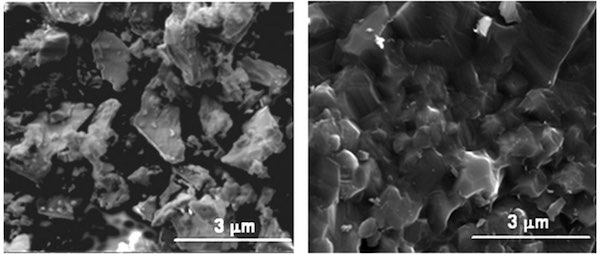
Flash spark plasma sintering has been hot ever since it first surfaced here on Ceramic Tech Today about six years ago. That’s because the technique has the ability to consolidate hard materials, even those that are difficult to deform, in a really short amount of time—a flash.
The technique uses an electrical current to rapidly speed up the sintering process, reducing a heating process that would otherwise take hours to mere seconds. That means huge time savings, energy savings, and thus money savings when it comes to processing ceramic materials.
In addition to the ability to save considerable time and energy required to process hard powder materials, flash spark plasma sintering is attractive because it can rapidly consolidate nano-powders yet still maintain nanostructures and sub-micron structures.
Other techniques, including cold sintering, have also been getting energy-saving and time-saving makeovers recently. And the September issue of the ACerS Bulletin included an article from scientists at Queen Mary University of London in the U.K. about the flash spark plasma sintering device they developed to rapidly sinter materials in a matter of seconds as well.
Researchers at San Diego State University now report that they have also developed an ultra-rapid method of flash spark plasma sintering that can really quickly densify even hard-to-deform materials.
“Using this process it was possible to consolidate silicon carbide powder up to full density in few seconds,” Eugene Olevsky, distinguished professor of mechanical engineering and associate dean for research and graduate studies at San Diego State University and first author of the paper describing the new work, writes in an email.
It’s like magic—but how can this process densify such hard-to-deform materials so quickly?
Olevsky and his colleagues explored the abilities of ultra-flash spark plasma sintering to quickly densify materials by using theoretical calculations to figure out what was going on being the scenes. The calculations supported their prediction that thermal runaway could explain such rapid densification of materials under flash spark plasma sintering.
Thermal runaway is a kind of uncontrolled positive feedback loop in which increasing the temperature within a material changes the reaction conditions to an extent that they cause further temperature increases.
While rapid temperature increases are the whole idea behind sintering, uncontrolled reactions are a bad thing when it comes to materials processing—and a really bad thing when it comes to your smartphone. Plus, thermal runaway non-uniformly densifies materials.
So the researchers integrated pressure into the process to keep thermal runaway in check during sintering. Therefore, the team calls their process flash hot pressing.
To rapidly and uniformly densify silicon carbide powder with flash hot pressing, the team experimented with a conventional spark plasma sintering device, tweaking the design of the sintering die.
“Conducting flash sintering in a device designed for spark plasma sintering requires extra thought in die design,” the authors write in the open-access Scientific Reports paper describing their work. “The goal is to pass current through the die alone, heating the specimen by radiation heating, then switching so that electrical current can only flow through the specimen.”
So the team specifically designed sacrificial dies that restrict current to the die itself, allowing indirect heating of the sample to a critical temperature before application of voltage through the sample itself—that way, the sample will only receive electric current under elevated temperature.
The team’s specially designed die consists of a sacrificial conducting collar made of copper, which buffers the sample from the electric current until the die reaches copper’s melting point. At that temperature, the collar deforms, allowing the sample to make contact with the electrical field.

Diagram and images of the sacrificial copper collar die before and after sintering. Credit: Scientific Reports; CC BY 4.0

SEM micrograph of SiC powder (left), and SiC specimen processed by flash hot pressing (right). Credit: Scientific Reports; CC BY 4.0
The design worked—the authors report that these preliminary studies with silicon carbide show a “high degree of almost instantaneous densification with limited grain growth.”
And because the authors used an industrial spark plasma sintering device, the technique could have widespread applicability to densify hard materials in seconds, saving precious processing time and significant amounts of energy for a variety of materials.
The paper, published in Scientific Reports, is “Flash (ultra-rapid) spark-plasma sintering of silicon carbide” (DOI: 10.1038/srep33408).
